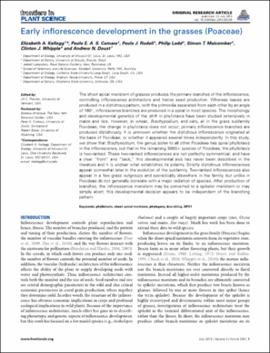| dc.contributor.author | Kellogg, Elizabeth A. | |
| dc.contributor.author | Camara, Paulo E. A. S. | |
| dc.contributor.author | Rudall, Paula J. | |
| dc.contributor.author | Ladd, Philip | |
| dc.contributor.author | Malcomber, Simon T. | |
| dc.contributor.author | Whipple, Clinton J. | |
| dc.contributor.author | Doust, Andrew N. | |
| dc.date.accessioned | 2019-08-28T16:00:45Z | |
| dc.date.available | 2019-08-28T16:00:45Z | |
| dc.date.issued | 2013-07-23 | |
| dc.identifier | oksd_kellogg_earlyinfloresce_2013 | |
| dc.identifier.citation | Kellogg, E. A., Camara, P. E. A. S., Rudall, P. J., Ladd, P., Malcomber, S. T., Whipple, C. J., & Doust, A. N. (2013). Early inflorescence development in the grasses (Poaceae). Frontiers in Plant Science, 4, Article 250. https://doi.org/10.3389/fpls.2013.00250 | |
| dc.identifier.uri | https://hdl.handle.net/11244/321365 | |
| dc.description.abstract | The shoot apical meristem of grasses produces the primary branches of the inflorescence, controlling inflorescence architecture and hence seed production. Whereas leaves are produced in a distichous pattern, with the primordia separated from each other by an angle of 180°, inflorescence branches are produced in a spiral in most species. The morphology and developmental genetics of the shift in phyllotaxis have been studied extensively in maize and rice. However, in wheat, Brachypodium, and oats, all in the grass subfamily Pooideae, the change in phyllotaxis does not occur; primary inflorescence branches are produced distichously. It is unknown whether the distichous inflorescence originated at the base of Pooideae, or whether it appeared several times independently. In this study, we show that Brachyelytrum, the genus sister to all other Pooideae has spiral phyllotaxis in the inflorescence, but that in the remaining 3000+ species of Pooideae, the phyllotaxis is two-ranked. These two-ranked inflorescences are not perfectly symmetrical, and have a clear “front” and “back;” this developmental axis has never been described in the literature and it is unclear what establishes its polarity. Strictly distichous inflorescences appear somewhat later in the evolution of the subfamily. Two-ranked inflorescences also appear in a few grass outgroups and sporadically elsewhere in the family, but unlike in Pooideae do not generally correlate with a major radiation of species. After production of branches, the inflorescence meristem may be converted to a spikelet meristem or may simply abort; this developmental decision appears to be independent of the branching pattern. | |
| dc.format | application/pdf | |
| dc.language | en_US | |
| dc.publisher | Frontiers Media | |
| dc.rights | This material has been previously published. In the Oklahoma State University Library's institutional repository this version is made available through the open access principles and the terms of agreement/consent between the author(s) and the publisher. The permission policy on the use, reproduction or distribution of the material falls under fair use for educational, scholarship, and research purposes. Contact Digital Resources and Discovery Services at lib-dls@okstate.edu or 405-744-9161 for further information. | |
| dc.title | Early inflorescence development in the grasses (Poaceae) | |
| osu.filename | oksd_kellogg_earlyinfloresce_2013.pdf | |
| dc.description.peerreview | Peer reviewed | |
| dc.identifier.doi | 10.3389/fpls.2013.00250 | |
| dc.description.department | Botany | |
| dc.type.genre | Article | |
| dc.type.material | Text | |
| dc.subject.keywords | shoot apical meristem | |
| dc.subject.keywords | phylogeny | |
| dc.subject.keywords | branching | |
| dc.subject.keywords | apo1 | |
| dc.subject.keywords | phyllotaxis | |
